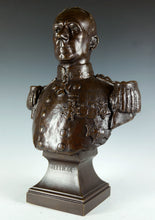Portrait Bust of Rear-Admiral Sir John Jellicoe, K.C.V.O., C.B., R.N., 1910
Adding product to your cart
Height: 36cm (14.25in)
Provenance: Neasham Hall, Co. Durham
The subject is portrayed in naval full dress uniform of a Rear-Admiral and wearing the neck badge and breast star of a Knight of Royal Victorian Order, together with the breast badge of a Companion of the Bath Egypt Medal (1882), China Medal (1900) and the Khedive’s Star. Signed to the rear of the left shoulder ‘Margaret Wrightson / S[culptor] 1910’.
Read more
The present bronze dates to the period of Jellicoe’s appointment as Third Sea Lord at the Admiralty and subsequent appointment in December 1910 as Commander-in-Chief, Atlantic Fleet. At this relatively early date Jellicoe was already well-known to the public at large, not least through his death defying exploits ashore when Captain of the battleship H.M.S. Centurion during the relief of the Peking legations in 1900; his attempt to save the lives of the crew of a Glasgow steamer when a lieutenant in H.M.S. Monarch (for which he was awarded the Board of Trades’s Sea Gallantry Medal), and for the subsequent loss of this award in a well publicised naval catastrophe - the sinking of H.M.S. Victoria on July 22, 1893, after a collision with H.M.S. Camperdown in the Mediterranean.
Admiral of the Fleet Sir John Rushworth Jellicoe, 1st Earl Jellicoe of Scapa, G.C.B., O.M., G.C.V.O., R.N. (1859-1935) was he was to become was also one of the most prominent public figures of First World War as the Commander-in-Chief of the Grand Fleet from 1914 to 1916. In May 1916 he commanded the Grand Fleet in the sea battle off Jutland that was to prove history's largest (and only major) clash of dreadnoughts. His handling of the fleet however remains controversial, with some historians describing Jellicoe’s approach as too cautious and other historians faulting the battlecruiser commander, Admiral David Beatty for tactical errors. Jellicoe certainly made no significant mistakes and correctly deployed the Grand Fleet with a the classic naval warfare tactic of ‘crossing the T’ of the German High Seas Fleet as it appeared. After suffering heavy shell damage, the enemy fleet turned 180 degrees and fled the battle area. Jellicoe was criticised for not pursuing but it is questionable whether this would have been sensible, given the risk of German torpedo attacks. At the time the British public were disappointed that the Royal Navy had not won a victory on the scale of the Trafalgar. Winston Churchill later described Jellicoe later as 'the only man on either side who could lose the war in an afternoon'—essentially hinting that Jellicoe's decision to prefer caution was strategically correct.
After Jutland the German fleet rusted in the Kiel Canal, or were dismantled, and never again ventured beyond the mine fields protecting their bases. The sea power of Germany was effectively broken as was later evinced in the spectacle of the huge fighting ships of beaten Germany steaming sullenly into captivity at Scapa.
Margaret Jane Wrightson, A.R.B.S. (1877-1976) was the daughter of Sir Thomas Wrightson,1st Baronet, marine engineer and magistrate. She studied at the Royal College of Art under William Blake Richmond and Edouard Lanteri, and exhibited at the Royal Academy, the Walker Art Gallery and at the Society of Women Artists from 1906. She lived and worked in a studio in Bedford Gardens, London, and never married. Her public sculptures are a small figure of St. George on the war memorial at Cramlington, Northumberland (1922) and the statue of a boy commemorating Charles Lamb (1928) in the gardens of the Inner Temple in the City of London. Her private commissions included ‘The Viking landing on the Northumberland Coast’ in 1925 for Sir Walter Runciman, and a number of portrait busts of the daughters of the 7th Marquess and Marchioness of Londonderry.






